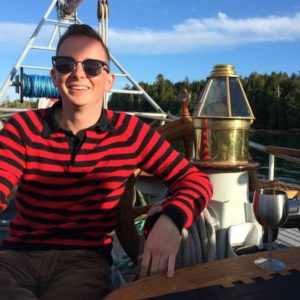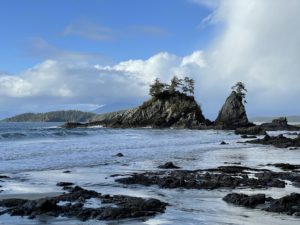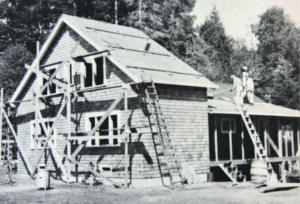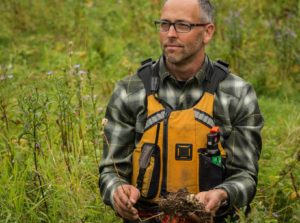In recent Logbook entries we’ve been focusing on the history of Outer Shores Lodge as it relates to the lodge’s original founder R. Bruce Scott. You can read Part I, Part II, and Part III of that three-part Logbook series by clicking the links.
In this Logbook entry we look at one interesting quirk of nomenclature in the history of Bamfield, the home of Outer Shores Lodge, and how it came to acquire its misspelled moniker.
Today, Bamfield is a remote fishing and marine science community located on the west coast of Vancouver Island. It’s located on the traditional territory of the Huu-ay-aht First Nations, on the doorstep of Pacific Rim National Park Reserve, which includes the Broken Group Islands, an archipelago for more than 300 islands.
We love learning about the millions of years of natural history and thousands of years of human history that makes this part of the world an incredible place to explore and experience across all our excursions and activities at Outer Shores Lodge, but for this particular Logbook entry we’re going to be specifically taking a quick and focused look at the history of how the village now known as Bamfield came to be known by that name.
Modern Bamfield, British Columbia
According to the most recent census data, the village of Bamfield has about 200 inhabitants, and it is divided into two parts: East Bamfield and West Bamfield, separated by the Bamfield Inlet. Outer Shores Lodge itself is located in West Bamfield, which can only be accessed by water or air. In addition to Outer Shores Lodge, West Bamfield is also home to the village’s quaint and historic waterfront boardwalk. The boardwalk – which is usually one of the first places guests of Outer Shores Lodge visit and is located just a couple minutes away from the lodge – connects many of the homes, businesses, and docks on this side of the Bamfield Inlet.
The Huu-ay-aht First Nations, one of 14 Nuu-chah-nulth nations along the west coast of Vancouver Island, have inhabited the area around Bamfield for thousands of years, including the village of ʔuc̓uuʔa (pronounced “ootsuu-a”), which stood for centuries at the current site of Outer Shores Lodge. Huu-ay-aht whalers in particular were fond of this unique site for its formidable views out into the ocean, a characteristic we still have the privilege of enjoying at the lodge today.
Banfield Comes to Bamfield
In 1846, one William Eddy Banfield first came out to this region aboard the H.M.S. Constance, on which he served as part of the ship’s carpenter crew. Banfield would leave British service in 1849 and spend several years working at the trading post for the Anderson & Company of Victoria, trading with the Nuu-chah-nulth nations from about 1854 to 1858. He lived at the inlet, which, resultantly, came to be known as Banfield’s Creek. It was first misspelled as Bamfield on British Admiralty Charts in 1863 and 1865, but was corrected to Banfield Creek in subsequent issues of the charts.
Over the years, William Banfield became familiar with the local Indigenous communities and their languages, and as a result he began publishing his ethnographic writings in the Daily Victoria Gazette, to the point that some academics and politicians of the time considered him “a foremost authority on the culture and territories of the [Indigenous] people,” according to author David A. Rossiter in ‘Lessons in possession: colonial resource geographies in practice on Vancouver Island, 1859–1865.’
As a result, Banfield was selected as an “Indian Agent” for the region after an alleged incident between First Nations and the U.S. Merchant Ship Swiss Boy had damaged relations between the British and the Huu-ay-aht. Banfield was tasked with securing “an agreement for land use” in Barkley Sound as colonist investors wanted to build and operate a forestry mill on the land.
It is believed that in 1859 Chief Tliishin and Chief Howeesem agreed to the land purchase agreement by affixing strips of sacred cedar bark to the land purchase document. However, considering the cultural conventions of the Huu-ay-aht, it is very likely that Chief Tliishin considered Banfield’s payment as rent or an homage, rather than a purchase of the land. As Rossiter argues in the Journal of Historical Geography, Banfield prepared the land for the mill and managed the arrival of the colonizers in Barkley Sound through threats and violence directed at the Huu-ay-aht people.
Banfield’s Mysterious Death
Banfield died under mysterious circumstances on October 20, 1862, just off the coast of where Outer Shores Lodge sits today. It was first reported by a member of the Huu-ay-aht community that he had drowned when he fell from his canoe. But there were soon accusations by the colonizers that Chief Tliishin had been involved in his death. The British colonizers threatened violence against the Huu-ay-aht, eventually arresting three Huu-ay-aht men who were supposedly involved in Banfield’s death. All accused parties were acquitted before a judge in Victoria on account of weak evidence from the prosecutors. Local speculation long continued around whether or not Banfield’s death was accidental, or something more .
Some four decades later, the name Banfield Creek was still being used to refer to the inlet, which was chosen as the northern terminus of the 11,000 kilometre submarine cable line linking the British possessions in North America to the British Commonwealth of Australia, and would soon bring R. Bruce Scott to Bamfield for the first time. The first message was transmitted to the cable station in December of 1902.
The Second Misspelling of Banfield
Just one year later, the first post office was opened at the station, and it accidentally bore the name “Bamfield Post Office.” While the misspelling of Banfield was quickly acknowledged by the local postal authorities, corrected stamps were never issued to the “Banfield Postmaster” and the misspelling simply stuck.
The inlet, now properly recognized as an inlet rather than a creek, continued to be known as Banfield Inlet for most of the next half-century, but even the inlet’s name had to eventually succumb to the overwhelmingly popular use of Bamfield over Banfield. The misspelling was here to stay as of 1951, when what had once been known as Banfield Creek officially became Bamfield Inlet, bringing an end to any formal use of the name Banfield to identify the area’s geography from that point on.
Thanks to our sources ‘The Colonial Despatches‘ from the University of Victoria and the BC Government’s ‘BC Geographical Names‘ resources.










